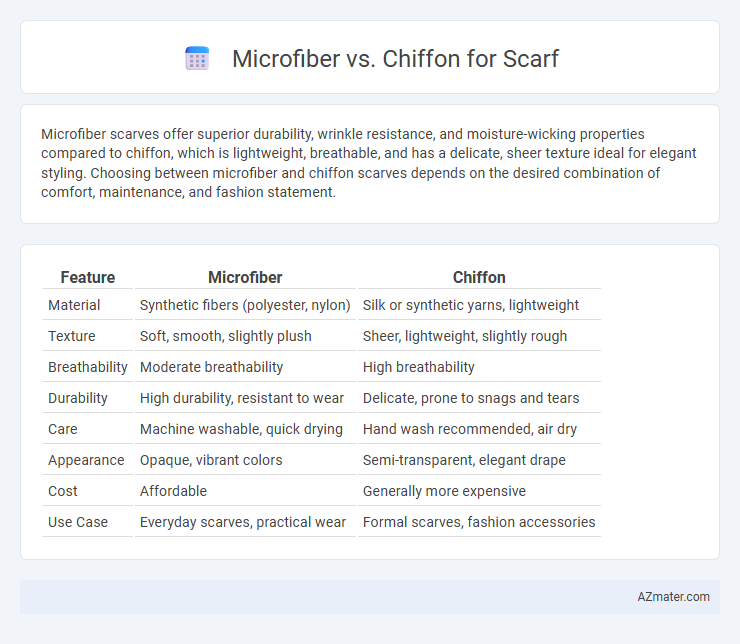Microfiber scarves offer superior durability, wrinkle resistance, and moisture-wicking properties compared to chiffon, which is lightweight, breathable, and has a delicate, sheer texture ideal for elegant styling. Choosing between microfiber and chiffon scarves depends on the desired combination of comfort, maintenance, and fashion statement.
Table of Comparison
| Feature | Microfiber | Chiffon |
|---|---|---|
| Material | Synthetic fibers (polyester, nylon) | Silk or synthetic yarns, lightweight |
| Texture | Soft, smooth, slightly plush | Sheer, lightweight, slightly rough |
| Breathability | Moderate breathability | High breathability |
| Durability | High durability, resistant to wear | Delicate, prone to snags and tears |
| Care | Machine washable, quick drying | Hand wash recommended, air dry |
| Appearance | Opaque, vibrant colors | Semi-transparent, elegant drape |
| Cost | Affordable | Generally more expensive |
| Use Case | Everyday scarves, practical wear | Formal scarves, fashion accessories |
Overview: Microfiber vs Chiffon Scarves
Microfiber scarves offer a soft, lightweight feel with excellent durability and moisture-wicking properties, making them ideal for daily wear and active lifestyles. Chiffon scarves are known for their sheer, delicate texture and elegant drape, often preferred for formal occasions and stylish layering. Both fabrics provide versatile options, but microfiber excels in functionality while chiffon emphasizes aesthetic appeal.
Fabric Composition: What Are Microfiber and Chiffon?
Microfiber is a synthetic fabric made from ultra-fine polyester or nylon fibers, prized for its softness, durability, and moisture-wicking properties, making it ideal for scarves that require lightweight comfort and easy maintenance. Chiffon is a lightweight, sheer fabric traditionally made from silk or synthetic fibers like polyester, characterized by a slightly rough texture and a delicate, flowing drape, often used for elegant and breathable scarves. The fundamental difference lies in microfiber's dense, tightly woven construction versus chiffon's open weave, influencing scarf texture, appearance, and suitability for various styles and weather conditions.
Texture and Feel: Comfort Comparison
Microfiber scarves offer a smooth, silky texture that feels lightweight and soft against the skin, making them ideal for all-day comfort without irritation. Chiffon scarves provide a delicate, sheer feel with a slightly crisp texture that enhances breathability but may feel less smooth compared to microfiber. Both materials ensure comfort, with microfiber excelling in softness and chiffon delivering an airy, elegant drape.
Breathability and Temperature Regulation
Microfiber scarves excel in moisture-wicking properties, enabling efficient breathability and maintaining a comfortable temperature by dispersing heat quickly. In contrast, chiffon scarves offer lightweight and airy fabric that promotes airflow, enhancing ventilation and reducing heat retention. Both materials provide effective temperature regulation, but microfiber tends to perform better in active or warmer conditions due to its synthetic fiber technology.
Durability: Which Lasts Longer?
Microfiber scarves typically offer superior durability compared to chiffon, as the synthetic fibers resist wear, shrinking, and wrinkling over time. Chiffon, often made from silk or lightweight polyester, tends to be more delicate, prone to snags and fraying with frequent use. For long-lasting wear, microfiber scarves provide enhanced strength and resistance to damage, making them ideal for daily or rougher handling.
Style and Appearance: Sheen & Drape Differences
Microfiber scarves offer a smooth, consistent sheen and a heavier drape that creates elegant, structured folds, enhancing a polished and modern look. Chiffon scarves feature a lightweight, semi-translucent fabric with a subtle, natural matte finish and a fluid, airy drape that delivers a soft, romantic aesthetic. The choice between microfiber and chiffon significantly affects the scarf's visual impact, with microfiber emphasizing sleek sophistication and chiffon highlighting delicate, flowing femininity.
Maintenance: Washing and Care Tips
Microfiber scarves require gentle machine washing with cold water and mild detergent to maintain their softness and prevent damage, while chiffon scarves demand even more delicate hand washing or dry cleaning to preserve their lightweight, sheer texture. Avoid using bleach or harsh chemicals on both fabrics, and air drying is recommended to prevent shrinkage or distortion. Proper storage in a cool, dry place away from direct sunlight helps extend the lifespan of both microfiber and chiffon scarves.
Versatility: Occasions and Outfits
Microfiber scarves provide exceptional versatility by complementing both casual and formal outfits with their smooth texture and lightweight feel, making them ideal for everyday wear and office settings. Chiffon scarves offer a delicate, sheer appearance that enhances evening wear and special occasions, adding an elegant touch to dresses and blouses. Both materials adapt well to layering, but microfiber's durability suits active lifestyles, while chiffon's airy fabric elevates sophisticated ensembles.
Price Point: Affordability of Each Fabric
Microfiber scarves typically offer a more affordable price point compared to chiffon, making them a budget-friendly choice for everyday wear. Chiffon, often made from silk or high-quality synthetic fibers, tends to have a higher cost due to its delicate texture and luxurious appearance. Consumers seeking elegance on a budget often prefer microfiber, while those prioritizing premium fabric and drape may invest more in chiffon scarves.
Which One to Choose: Microfiber or Chiffon for Scarves?
Microfiber scarves offer superior durability, wrinkle resistance, and moisture-wicking properties, making them ideal for everyday wear and active lifestyles. Chiffon scarves provide a lightweight, breathable texture with a soft, elegant drape, perfect for formal occasions and delicate styling. Choosing between microfiber and chiffon depends on the desired balance between practicality and sophistication for scarf use.

Infographic: Microfiber vs Chiffon for Scarf
 azmater.com
azmater.com